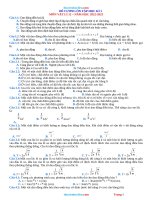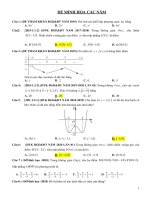A method for constructing public-key block cipher schemes based on elliptic curves
Bạn đang xem bản rút gọn của tài liệu. Xem và tải ngay bản đầy đủ của tài liệu tại đây (356.4 KB, 8 trang )
Computer science and Control engineering
A method for constructing public-key block cipher schemes
based on elliptic curves
Luu Hong Dung*
Military Technical Academy.
*
Corresponding author:
Received 16 Sep 2022; Revised 2 Dec 2022; Accepted 12 Dec 2022; Published 30 Dec 2022
DOI: />
ABSTRACT
The article proposes a method for constructing public-key block cipher schemes based on the
difficulty of the discrete logarithm problem on elliptic curves. The schemas are construc
according to the proposed method and can simultaneously perform security functions and
authenticate the origin and integrity of the encrypted message. In addition, a shared secret key is
established between the sender/encryptor and the receiver/decryptor for each encrypted message
based on public key cryptography which also improves the security of these cipher schemes.
Keywords: Symmetric key cryptography; Public key cryptography; Block cipher; Encryption – Authentication
schemes; Discrete logarithm problem on elliptic curves.
1. INTRODUCTION
In [1-3], a solution was proposed for constructing block cipher schemes based on
OTP cipher [4]. The benefit of algorithms constructed in accordance with solution is that
they inherit the security and efficiency of the OTP cipher [1-3], but the shared secret key
between sender/encryptor and receiver/decryptor may be reused several times.
Additionally, the construction, management, and distribution of keys are carried out
similarly to other symmetric-key cryptosystems currently being applied in practice
(DES, AES, etc.). The paper proposes a method for constructing public-key block cipher
schemes based on the difficulty of the discrete logarithm problem on elliptic curves.
Under this method, a shared secret key is established between the sender/encryptor and
the receiver/decrypter for each message to be encrypted based on the mechanism of
public key cryptography, which helps improve the security of these cipher schemes. The
proposed method here can be applied to block cipher algorithms constructed according to
solution in [1-3] as well as to commonly used block cipher algorithms in practice such
as: DES, AES, etc.
2. METHOD FOR CONSTRUCTING PUBLIC-KEY BLOCK CIPHER SCHEMES
2.1. Proposed method
The method for constructing public key block cipher schemes proposed here includes
the Key Generation Algorithm, the Encryption Algorithm and the Decryption –
Authentication Algorithm, described as follows:
2.1.1. Key Generation Algorithm
The End User's key is generated by the key generation algorithm from the set of
domain parameters, which includes:
- p is a prime number specifying the underlying finite field Fp.
- E(Fp) is Elliptic curve defined on the finite field Fp by equation E(a,b):
y 2 = x 3 + ax + b with: a , b Fp and satisfied: 4a 3 + 27b2 0 mod q
114
Luu Hong Dung, “A method for constructing public-key block … based on elliptic curves.”
Research
- G is the base point in E(Fp).
- q is the order of G in E(Fp).
Attention:
In order for the discrete logarithm problem to be difficult to solve on E(Fp), the
domain parameter set can be selected according to ISO/IEC 15946 [5], ANSI X9.62 [6]
or FIPS PUB 186-4 [7].
The p, a, b, G, q parameters are system parameters or domain parameters
generated by the service provider and (d,P) are the secret, public key pair of the End
User (sender/encryptor, receiver/decryptor). The Key generating algorithm is
described as follows:
Algorithm 1.1:
input: E(Fp) = (p, a, b, G, q).
output: (d,P).
[1]. Generate the secret key d in the range (1,q):
d = RNG({1,2,…,q-1})
[2]. Calculate the public key P by:
P = (xp, yp) = d . G
Notes:
- RNG(): Random or pseudo-random number generator.
- (xp, yp): The coordinates of the point P on E(Fp).
Suppose, ds is the secret key of the sender (encryptor) and dr is the secret key of the
receiver (decryptor), then the corresponding public keys of the sender are:
Ps = (xps, yps) = ds.G
and of the receiver are:
Pr = (xpr, ypr) = dr.G
2.1.2. Encryption algorithm
Algorithm 1.2:
input: E(Fp) = (p, a, b, G, q), ds, Pr, M1.
output: (R,C).
[1]. Calculate the Se according to the formula:
Se = (xse, yse) = ds . Pr
[2]. Calculate the value R follow:
R = F1(M1, xse)
[3]. Calculate the sender's encryption key Ke:
Ke = F1(R, xse)
[4]. Encrypt the message to be sent M1 according to:
C = Encrypt(Ke, M1)
[5]. Send ciphertext (R,C) to the receiver.
Notes:
- F1(): Cryptographic hash function, eg: SHA-1/SHA256 [8], etc.
- (xse, yse): Coordinates of the point Se on E(Fp).
In this scheme, Encrypt() is an encryption function with a symmetric key Ke
Journal of Military Science and Technology, Special issue No.6, 12- 2022
115
Computer science and Control engineering
constructed according to the solution in [1-3] then the plaintext M is encrypted as n data
blocks Mi of size m bits:
M = {M1, M2,…, Mn}
The output of Encrypt() which is the C component of the ciphertext also includes n
data blocks Ci of size m bits:
C = {C1, C2,…, Cn}
One time use key KOT consists of n subkeys Ki whose size corresponds to the size of
the plaintext block:
KOT = {K1, K2,…, Kn} với: K1 = Ke
The encryption function Encrypt() is described as follows:
Algorithm 1.3:
input: M = {M1, M2,…, Mn}, Ke.
output: C = {C1, C2,…, Cn}.
[1]. K1 = Ke
[2]. for i = 1 to n do
begin
Ci = Mi Ki
Ki+1 = F2(Mi, Ki)
end
[3]. return C
Notes:
- The operation is the addition modulo 2 (XOR) of two bit strings.
- F2() is a Random or Pseudo-random number generator function.
2.1.3. Decryption – Authentication Algorithm
Algorithm 1.4:
input: E(Fp) = (p, a, b, G, q), dr, Ps, (R,C).
output: M2.
[1]. Calculate the Sd according to the formula:
Sd = (xsd, ysd) = dr . Ps
[2]. Calculate receiver's decryption key Kd:
Kd = F1(R, xsd)
[3]. Decrypt the received message C according to:
M2 = Decrypt(Kd, C)
[4]. Calculate the value V according to:
V = F1(M2, xsd)
[5]. Checks if: V = R then: M2 = M1, means that the origin and integrity of the
post-decrypted message is confirmed.
Note:
- (xsd, ysd): Coordinates of the point Sd on E(Fp).
The decryption function with the symmetric key Decrypt() is constructed according
to the solution in [1-3] with the input as the C component of the ciphertext and the
shared secret key K, the output is the post-decrypted message M consisting of n data
block of size m bits:
116
Luu Hong Dung, “A method for constructing public-key block … based on elliptic curves.”
Research
M = {M1, M2,…, Mn}
One time use key KOT is similar to the sender/encryption side, consisting of n
subkeys of the size of the plaintext block:
KOT = {K1, K2,…, Kn} with: K1 = Kd
The decryption function Decrypt() then has the form:
Algorithm 1.5:
input: C = {C1, C2,…, Cn}, Kd.
output: M = {M1, M2,…, Mn}.
[1]. K1 = Kd
[2]. for i = 1 to n do
begin
Mi = Ci Ki
Ki+1 = F2(Mi, Ki)
end
[3]. return M
2.1.4. The correctness of the proposed scheme
What needs to be proved here is: if the received ciphertext is the same as the sent
ciphertext, then the message after decryption is also the message before encryption: M2 =
M1 and the condition: V = R will be satisfied. Therefore, after decryption if the
condition: V = R is satisfied, the receiver can confirm with certainty the origin and
integrity of the received message.
We have:
Sd = dr . Ps = dr . (ds . G) = ds . (dr . G) = ds .Pr = Se
Deduce: xsd = xse
So we also have:
Kd = F1(R, xsd) = F1(R, xse) = Ke
Therefore, we have the first proof:
M2 = Decrypt(Kd, C) = Decrypt(Kd, Encrypt(Ke, M1))
= Decrypt(Kd, Encrypt(Kd, M1)) = M1
Then, we have the second proof:
V = F1(M2, xsd) = F1(M1, xse) = R
2.2. An application scheme
An application implementation of the proposed method is to use the SHA-1 hash
function [8] to perform the roles of functions F1 and F2. In this scheme, the plaintext M1
is encrypted as n data blocks of size 160 bits:
M1 = {M11, M12, …, M1i, …, M1n}, i = 1, n , |M1i| = 160 bits
The sent ciphertext consists of two components R and C. Where, the size of R
corresponds to the size of the SHA-1 output data (160 bits) and C consists of n blocks of
data, each of 160 bits in size:
C = {C1, C2,…, Ci,…, Cn}, i = 1, n , |Ci| = 160 bits
Journal of Military Science and Technology, Special issue No.6, 12- 2022
117
Computer science and Control engineering
Key KOT consists of n subkeys Ki also 160 bits in size with K1 = Ke :
KOT = {K1, K2,…, Ki,…, Kn}, i = 1, n , |Ki| = 160 bits
The decrypted message M2 can be received as n blocks of data, each of 160 bits in size:
M2 = {M21, M22,…, M2i,…, M2n}, i = 1, n , |M2i| = 160 bits
Then the encryption and decryption algorithms of the scheme can be described in
detail as follows:
Algorithm 2.1 : Encryption.
input: E(Fp) = (p, a, b, G, q), ds, Pr, M1.
output: (R, C).
[1]. Calculate the Se according to the formula:
Se = (xse, yse) = ds . Pr
[2]. Calculate the value R follow:
R = SHA-1(M1||xse)
[3]. Calculate the sender's encryption key Ke:
Ke = SHA-1(R||xse)
[4]. K1 = Ke
for i = 1 to n do
begin
Ci = M1i Ki
Ki+1 = SHA-1(M1i||Ki)
end
[5]. Send ciphertext (R,C) to the receiver.
Note:
- The operation “||” is the concatenation operator of two bit strings.
Algorithm 2.2 : Decryption – Authentication.
input: E(Fp) = (p, a, b, G, q), dr, Ps, (R,C).
output: M2.
[1]. Calculate the Sd according to the formula:
Sd = (xsd, ysd) = dr . Ps
[2]. Calculate the value of the decryption key Kd:
Kd = SHA-1(R||xsd)
[3]. K1 = Kd
for i = 1 to n do
begin
M2i = Ci Ki
Ki+1 = SHA-1(M2i||Ki)
end
[4]. Calculate the value of V according to:
V = SHA-1(M||Sd)
[5]. Check if: V = R then return the result: M2 = {M21,M22 ,, …,M2n }.
Otherwise, if: V ≠ R then: return M2 = {0,0,…,0}.
118
Luu Hong Dung, “A method for constructing public-key block … based on elliptic curves.”
Research
Note:
- When receiving the message: M2 = {0,0,…,0} after decryption, the receiver
assumes that the message is tampered or a communication error has occurred. Otherwise,
this is the encrypted message.
2.3. Some evaluation of the security level of the proposed scheme
The security level of the proposed scheme is assessed by its ability to resist some
typical attacks as follows:
Ciphertext-only attack: To decrypt a message, an attacker needs to compute either the
encryption key e or the decryption key d. First, the attacker needs to find out the sender 's
secret key ds to calculate Se by:
Se = (xse, yse) = ds . Pr
or find out the secret key dr of the receiver to calculate Sd:
Sd = (xsd, ysd) = dr . Ps
Then calculate the encryption key:
Ke = F1(R, xse)
or calculate the decryption key:
Kd = F1(R, xsd)
However to calculate ds from:
Ps = ds . G
or dr from:
Pr = dr . G
The attacker needs to solve the discrete logarithm problem on E(Fp). Currently, no
polynomial–time algorithm has been published for this difficult problem [9].
- Known-plaintext attack: In this case, it makes no sense to calculate e or d, because
this key is used only once for an encrypted message. But the attacker can still find Se or
Sd to calculate e or d for later encryption sessions. Then, in addition to solving the
discrete logarithm problem on E(Fp) like the above case, the attacker can also rely on the
public message m1 to calculate Se according to:
R = F1(M1, xse)
However, in this way, the attacker cannot achieve his goal because of the one-way
nature of the hash function.
- Spoofing attack: In the proposed scheme, an attacker who wants to impersonate a
certain sender to send a forged message to the receiver needs to obtain the secret
parameter Se or Sd of the sender or receiver. But from the above analysis, it is not
possible if the attacker cannot solve the discrete logarithm problem on E(Fp) or the
problem of the one-wayness of the hash function. Furthermore, the post–decrypted
message is only authenticated for its origin and integrity when the following conditions
are satisfied:
F1 (M2, xsd) = F1(M1, xse)
Due to the collision resistance of the hash function, to satisfy the above condition, it is
Journal of Military Science and Technology, Special issue No.6, 12- 2022
119
Computer science and Control engineering
necessary to satisfy the following two conditions simultaneously: M2 = M1 and: Sd = Se.
With the first condition: M2 = M1 the receiver can fully confirm the integrity of the
message after decryption, and the origin of the message is authenticated based on the
condition: Sd = Se as follows: Since the receiver uses the public key Ps of the sender to
generate Sd follow:
Sd = dr . Ps
Should be to: Sd = Se then Se must be generated from the sender's secret key ds by:
Se = ds . Pr
Only the owner of the public key ys knows the corresponding secret key ds, i.e. only
the owner of the public key Ps is capable of generating Se equal to Sd of the receiver,
which allows the receiver to verify that the source of the decrypted message was
generated by the owner of the public key Ps. When an attacker sends a spoofed message
to a receiver using a value different from the key ds of the sender it is impersonating
(because the attacker does not know the ds of the impersonated sender), the value Sd
generated by the receiver will be different from the Se of the impostor, resulting in the
message being rejected.
5. CONCLUSIONS
The article proposes a method for constructing block cipher schemes based on the
mechanism of public key cryptography. The advantage of encryption schemes based on
this method is that although the security and efficiency of the OTP are preserved, but the
shared secret key is only used to encrypt each message. These are very important
properties for these cipher schemes to be applicable in practice. Additionally, because of
the process for authenticating the origin and integrity of the encrypted message, these
cipher schemes are resistant to spoofing attacks, which is one of the fundamental
requirements for real-world applications.
REFERENCES
[1]. Luu Hong Dung, Nguyen Anh Viet. "A solution to build a symmetric-key cryptosystem".
Information Security Magazine, Issue 5 (057) (2020).
[2]. Luu Hong Dung, Tong Minh Duc, Bui The Truyen. "Variant of OTP cipher with symmetrickey solution". Journal of Science and Technique - Section on Information and
Communication Technology (ICT) - No. 16 (2020), Le Quy Don Technical University.
ISSN: 1859 - 0209. DOI: 10.56651/lqdtu.jst.v9.n02.210.ict
[3]. Luu Hong Dung, Nguyen Anh Viet, Doan Thi Bich Ngoc. An encryption and authentication
algorithm developed based on the one – time pad cipher. Journal of Military Science and
Technology, ISSN: 1859 - 1403. (2020). DOI: 10.54939/1859-1043.j.mst.87-93.
[4]. Gilbert Vernam . US Patent 1,310,719. (1919).
[5]. ISO/IEC 15946: Information technology – Security techniques – Cryptographic Techniques
Based on Elliptic Curves, (1999).
[6]. ANSI X9.62. Public Key Cryptography for the Financial Services Industry: Elliptic Cuve
Digital Signature Algorithm (ECDSA), (1999).
[7]. National Institute of Standards and Technology, NIST FIPS PUB 186-4. Digital Signature
Standard, U.S. Department of Commerce, (2013).
[8]. National Institute of Standards and Technology, NIST FIPS PUB 180-1. (1995).
[9]. Lawrence C. Washington. "Elliptic curves – Number Theory and Cryptography". Chapman
& Hall/CRC, (2003).
120
Luu Hong Dung, “A method for constructing public-key block … based on elliptic curves.”
Research
TÓM TẮT
Một phương pháp xây dựng các lược đồ mã khối khóa cơng khai
dựa trên đường cong elliptic
Bài báo đề xuất phương pháp xây dựng các lược đồ mã khối khóa cơng
khai dựa trên độ khó của bài tốn logarit rời rạc trên đường cong elliptic. Các
lược đồ được xây dựng theo phương pháp đề xuất ở đây có thể đồng thời thực
hiện chức năng bảo mật và xác thực nguồn gốc và tính tồn vẹn của thơng điệp
mã hóa. Ngồi ra, một khóa bí mật dùng chung được thiết lập giữa người
gửi/người mã hóa và người nhận/người giải mã cho mỗi tin nhắn được mã hóa
dựa trên mật mã khóa cơng khai, điều này cũng giúp cải thiện tính bảo mật của
lược đồ mã khối.
Từ khố: Mật mã khóa đối xứng; Mật mã khóa cơng khai; Mã khối; Các lược đồ mã hóa – xác thực; Bài tốn logarit
trên đường cong elliptic.
Journal of Military Science and Technology, Special issue No.6, 12- 2022
121


